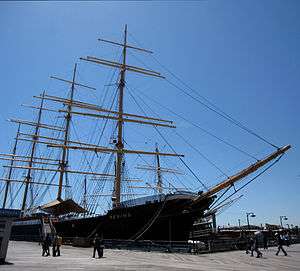Peking (ship)
Coordinates: 40°42′19″N 74°00′11″W / 40.70528°N 74.00306°W
 The Peking was docked at the South Street Seaport in New York City, where she acted as a maritime museum | |
| History | |
|---|---|
| Name: | Peking |
| Operator: | F. Laeisz |
| Route: | Europe–Chile |
| Builder: | Blohm & Voss, Hamburg |
| Laid down: | 1911 |
| Fate: | Interned at Valparaiso, and handed over to Italy as war reparations |
| Fate: | Sold back to F. Laeisz, 1923 |
| Name: | Peking |
| Operator: | F. Laeisz |
| Route: | Europe–Chile |
| Acquired: | 1923 |
| Fate: | Sold to Shaftesbury Homes, 1932 |
| Name: | Arethusa II |
| Homeport: | Upnor, Medway |
| Name: | HMS Pekin |
| In service: | World War II |
| Name: | Peking |
| Acquired: | 1975 |
| Homeport: | New York City |
| Fate: | Museum ship |
| General characteristics | |
| Class and type: | Flying P-Liner |
| Displacement: | 3,100 long tons (3,150 t) |
| Length: |
|
| Beam: | 45 ft 7 in (13.89 m) |
| Height: | 170 ft 6 in (51.97 m) |
| Draft: | 16 ft (4.9 m) |
| Sail plan: | 44,132 sq ft (4,100.0 m2) sail area |
The Peking is a steel-hulled four-masted barque. A Flying P-Liner of the German company F. Laeisz, it was one of the last generation of windjammers used in the nitrate trade and wheat trade around the often treacherous Cape Horn.
History
Peking was made famous by the sail training pioneer Irving Johnson; his footage filmed on board during a passage around Cape Horn in 1929 shocked experienced Cape Horn veterans and landsmen alike at the extreme conditions Peking experienced.
She was in Valparaiso at the outbreak of World War I, and was awarded to Italy as war reparations. She was sold back to the original owners, the Laeisz brothers in 1923, and continued in the nitrate trade until traffic through the Panama Canal proved quicker and more economical.
In 1932, she was sold for £6,250 to Shaftesbury Homes. She was first towed to Greenhithe, renamed Arethusa II and moored alongside the existing Arethusa I. In July 1933, she was moved to her new permanent mooring off Upnor on the River Medway,where she served as a children's home and training school. She was officially "opened" by HRH Prince George on 25 July 1933. During World War II she served in the Royal Navy as HMS Pekin.
The Peking was retired in 1975 and sold to Jack Aron, for the South Street Seaport Museum in New York City, where she was still moored in 2016. However, the Seaport did not see the Peking as part of its long-term operational plans. A 2012 offer to return the ship to Hamburg where she was originally built. Thanks to Mr.Henning Schwarzkopf, who saved the 1911 barque Peking ship from being scrapped in NY. Jonathan Boulware, president of the South Street Seaport Museum, prefers to focus on the 1885 Wavertree Jonathan Boulware choose the Wavertree. Peter Stanford was the founding president of the South Street Seaport Museum, and the president of the National Maritime Historical Society. Mr. Stanford was also credited with helping to organize the flotilla of windjammers that assembled in New York Harbor to celebrate the nation’s bicentennial in 1976, & a similar event to celebrate the Statue of Liberty centennial in 1986. Here is the link: http://www.nytimes.com/2016/03/29/nyregion/peter-stanford-steward-of-new-yorks-maritime-history-dies-at-89.html?_r=0
Germany Saved the Peking after Peter Stanford died. Germany will ensure the preservation of the vessel. The New York Times In November 2015 the German government decided to purchase the ship, to be a part of the announced German Port Museum in Hamburg, for which €120 million were allocated.[1] Prior to returning to Europe she will leave for Staten Island for Caddell Dry Dock on September 6th to spend the Winter. Note: New Yorker's & the de Blasio administration failed to step in & support the Seaport Museum & the district’s public space. The festival marketplace better known as Pier 17 Seaport Museum, rose to
become NYC’s Number 3 history museum. In 1998, Congress even named it “America’s National Maritime Museum.” New York City refused to repair the museum buildings it managed because the Bloomberg administration had, in secret negotiations, agreed to evict the museum. Here is the link: http://nypost.com/2014/04/19/why-nyc-must-save-the-south-street-seaport/
Fabled ship Peking leaving NYC after 40 years, she is a sister to native New Yorkers, & the Peking was a big part of the hippie movement in 1974. After all she is a German American citizen. She will be missed. Historical preservationist with Passion: Dr.James M. Lindgren
See also
- "Ralph McTell" song about the Peking, "Around the Wild Cape Horn" from his album, "Somewhere Down the Road"
- Flying P-Liner "sisters" in Europe:
- Padua – still active as a sail training ship under Russian flag as Kruzenshtern
- Pamir – lost 1957 in the Atlantic
- Passat – museum ship in Germany, and sister-ship to the Peking
- Pommern – museum ship in Finland
- Other preserved barques
References
Notes
- ↑ "Millions For Hamburg's Historic Museums". Hamburg News. Retrieved 2 December 2015.
Bibliography
- Johnson, Irving. Round the Horn in a Square Rigger (Milton Bradley, 1932) (reprinted as The Peking Battles Cape Horn (Sea History Press, 1977 ISBN 0-930248-02-3)
- Johnson, Irving. Around Cape Horn (film) (Mystic Seaport, 1985) (from original 16 mm footage shot by Irving Johnson, 1929)
External links
![]() Media related to Peking (ship) at Wikimedia Commons
Media related to Peking (ship) at Wikimedia Commons
- The History of Shaftesbury Homes and the Arethusa, giving details of the purchase of the Pekin/Peking
- South Street Seaport Museum webpage